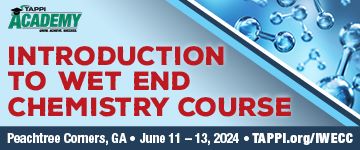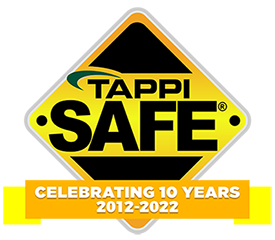 Search
Search
Use the search bar or filters below to find any TAPPI product or publication.
Filters
Content Type
Publications
Level of Knowledge
Collections
Magazine articles

The global wood fiber equation - a new world order?, TAPPI JOURNAL, January 1996, Vol. 79(1)
The global wood fiber equation - a new world order?, TAPPI JOURNAL, January 1996, Vol. 79(1)
Magazine articles

English as a first and second language - part 7: a strategy for spelling, TAPPI JOURNAL, October 1998, Vol.81(10)
English as a first and second language - part 7: a strategy for spelling, TAPPI JOURNAL, October 1998, Vol.81(10)
Magazine articles

The r & t system: everyone is responsible for innovation, TAPPI JOURNAL, September 2000, Vol. 83(9)
The r & t system: everyone is responsible for innovation, TAPPI JOURNAL, September 2000, Vol. 83(9)
Journal articles

Magazine articles

Economic and competitive potential of lignin-based thermoplastics using a multicriteria decision-making method, TAPPI Journal September 2022
ABSTRACT: As a result of new lignin extraction plants hatching and increasing volumes of technical lignin becoming available, a variety of lignin derivatives, including phenolic resins and polyurethane (PU) foams, are reaching the marketplace or being used as intermediate products in many industrial applications. In the spectrum of possible lignin derivatives, thermoplastics appear particularly attractive due to a symbiosis of market, policy, and technology drivers. To assess the preferredness for lignin-based thermoplastics, this paper adapted a risk-oriented methodology formerly applied to assess lignin usage in various applications (phenol-formaldehyde [PF] resins, PU foams, and carbon fiber applications) to the case of lignin-based thermoplastics using hydroxypropylated lignin (HPL) and miscible blends of lignin and polyethylene oxide (PEO). The HPL is considered for garbage bags and agricultural films applications, while lignin-PEO blends are used as replacement for acrylonitrile butadiene styrene (ABS) in applications such as automotive parts. In the methodology, two phased-implementation strategies were defined for each thermoplastic derivative, considering perspectives for profit maximization (90 metric tons/day integrated units) and revenue growth (350 metric tons/day overall capacity), which were considered for implementation within a softwood kraft pulping mill. A set of six criteria representative of the main economic and market competitiveness issues were employed, and their respective importance weights were obtained in a multicriteria decision-making (MCDM) panel.Early-stage techno-economic estimates were done as a basis for the calculation of decision criteria. Compared to product derivatives previously assessed, capital investment for thermoplastic strategies appeared marginally higher due to the required lignin modification steps (on average 30% higher at similar capacity, and 6% for higher-scale revenue diversification strategies). Higher operating costs were also observed due to increased chemical expenses for all thermoplastic strategies, which are ultimately balanced by revenues associated with targeted thermoplastic products, leading to greater annual margins and cash flow generation over the project lifetime for thermoplastic strategies compared to other product applications (58% to 66% higher on average, at similar scale). Benefits of improved economics were reflected in economic criteria, internal rate of return (IRR), and cash flow on capital employed (CFCE), as well as in the price competitiveness criterion, CPC. Overall, the combination of relatively high lignin content in the plastic formulation and the less costly modification method contributed to lignin-PEO strategies, gaining the top two rankings. Based on their overall scores, both strategies defined for HPL would also integrate the group of “preferred” strategies, but are outranked by strategies that consider lignin positioning on PU foam applications.
Magazine articles

Operations teams run a woodyard, TAPPI JOURNAL, December 1996, Vol. 79(12)
Operations teams run a woodyard, TAPPI JOURNAL, December 1996, Vol. 79(12)
Magazine articles

Modern management, technology, make skogn significant newsprint maker, TAPPI JOURNAL, March 1991, Vol. 74(3)
Modern management, technology, make skogn significant newsprint maker, TAPPI JOURNAL, March 1991, Vol. 74(3)
Magazine articles

Alkaline peroxide mechanical pulping of hardwoods, TAPPI JOURNAL, June 1991, Vol. 74(6)
Alkaline peroxide mechanical pulping of hardwoods, TAPPI JOURNAL, June 1991, Vol. 74(6)
Magazine articles

Mondi in south africa, TAPPI JOURNAL, April 1999, Vol. 82(4)
Mondi in south africa, TAPPI JOURNAL, April 1999, Vol. 82(4)
Journal articles

Magazine articles

Non-process elements in the recovery cycle of six Finnish kraft pulp mills, TAPPI Journal March 2023
ABSTRACT: In this work, the aim was to study the distribution and accumulation of the non-process elements (NPEs) in the recovery cycle of Finnish pulp mills and look at whether the geographical location (North vs. South) correlates with the current Finnish NPE levels. In addition, a comparison to older similar Finnish measurements was made with an attempt to analyze the reasons behind differences in the most typical non-process elements, aluminum (Al), silicon (Si), calcium (Ca), phosphorus (P), magnesium (Mg), manganese (Mn), chlorine (Cl), and potassium (K), taking into account the main elements in the white liquor, sodium (Na) and sulfur (S). The extensive laboratory results gained in this study are from seven sampling points at six pulp mills and present analytical data of metal concentrations. The data obtained presents an update to previous NPE studies. The levels found did not statistically differ between North and South Finland. The NPE levels, apart from phosphorus, found in Finnish pulp mills today have not changed considerably compared to the levels in earlier investigations in the 1990s. In the newest data, the phosphorus concentration was consistently higher in the as fired black liquor, electrostatic precipitator (ESP) ash, lime mud, and green liquor than in the previous results. In addition, the levels of Al, Si, Ca, P, and Mg in recovery boiler ESP ash were consistently higher compared to the older results. As the mills start to close their systems more, a stronger accumulation of NPEs can be expected, increasing the likelihood of more operational problems in the process. Further understanding of where the NPEs accumulate and how they can be most effectively removed will be valuable knowledge in the future.
Journal articles

Magazine articles

Considerations in managing wastewater odor at pulp and paper operations, TAPPI Journal March 2022
ABSTRACT: Many pulp and paper mills are, at least periodically, faced with the release of odors that can migrate offsite and be considered a nuisance by nearby residents. At chemical pulp mills, perceptible odors associated with reduced sulfur compounds (RSCs) are common, many of which are highly perceptible owing to their low odor thresholds. As releases of RSCs and other odorous substances from production processes are progressively controlled, the proportional contribution from wastewater treatment systems to areal odors can increase. This review paper summarizes important fundamentals of odor generation, source identification, and control. Common odorous substances are identified, and mechanisms for their generation are summarized. Approaches for measuring odorous substances are detailed to enable more effective management, and various odor control strategies are discussed.






